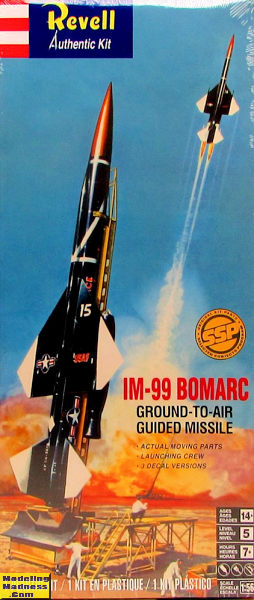
Revell 1/56 IM-99 Bomarc
| KIT #: | 85-1806 |
| PRICE: | $23.95 SRP |
| DECALS: | One option plus two for the OS2Us |
| REVIEWER: | Robert Myers |
| NOTES: | I |

| HISTORY |
The Boeing CIM-10 Bomarc (IM-99 Weapon System prior to September 1962) was a supersonic long-range surface-to-air missile (SAM) used during the Cold War for the air defense of North America. In addition to being the first operational long-range SAM, it was the only SAM deployed by the US Air Force.
Stored horizontally in a launcher shelter with movable roof, the missile was erected, fired vertically using rocket boosters to high altitude, and then tipped over into a horizontal Mach 2.5 cruise powered by ramjet engines. This lofted trajectory allowed the missile to operate at a maximum range as great as 250 miles (400 km). Controlled from the ground for most of its flight, when it reached the target area it was commanded to begin a dive, activating an onboard active radar homing seeker for terminal guidance. A radar proximity fuse detonated the warhead, either a large conventional explosive or the W40 nuclear warhead.
The Air Force originally planned for a total of 52 sites covering most of the major cities and industrial regions in the US. The US Army was deploying their own systems at the same time, and the two services fought constantly both in political circles and in the press. Development dragged on, and by the time it was ready for deployment in the late 1950s, the nuclear threat had moved from manned bombers to the intercontinental ballistic missile (ICBM), while the Army had successfully deployed their own system that filled any possible role in the 1960s, in spite of Air Force claims to the contrary.
As testing continued, the Air Force reduced its plans to sixteen sites, and then again to eight with an additional two sites in Canada. The first US site was declared operational in 1959, but with only a single working missile. Bringing the rest of the missiles into service took years, by which time the system was totally obsolete. Deactivations began in 1969 and by 1972 all Bomarc sites had been shut down. A small number were used as target drones, and only a few remain on display today.
| THE KIT |
Perhaps due to the limited number of releases, the molds look superb. I saw very little flash and while you'll have ejector pin marks where you don't want them, it is no worse than other old kits. Surprisingly, this one has both engraved panel lines and a mass of raised rivets.
The missile itself only makes up a portion of the
kit. There are two steps devoted to this and here is where they show the decal
placement for the box art version. The next four steps are for the construction
of the launch base and the erector assembly. This is designed so that the launch
arm can be raised or lowered, just like on their Nike Ajax. The seventh & ninth
construction  step
is dedicated to a maintenance platform. This includes a rather amorphous
maintenance tech and an officer standing around with his hands in his pockets.
The eighth step is for decaling the other two options.
step
is dedicated to a maintenance platform. This includes a rather amorphous
maintenance tech and an officer standing around with his hands in his pockets.
The eighth step is for decaling the other two options.
Instructions are very much like they would have been in 1959 and are easy to follow. Generic color information is provided. The box art aircraft is in USAF dark blue with white tips to the flight surfaces. Then there is an overall ADC grey plane of an operational USAF unit and a similarly painted Canadian version. The decals are nicely done and quite glossy. I should note that to me, there is some sort of registration issue with the USAF insignia as the blue seems thicker at the top of the insignia than at the bottom. Perhaps a replacement would be in order.
| CONCLUSIONS |
| REFERENCES |
https://en.wikipedia.org/wiki/CIM-10_Bomarc
Back to the Main Page Back to the Previews Index Page
Back to the Previews Index Page